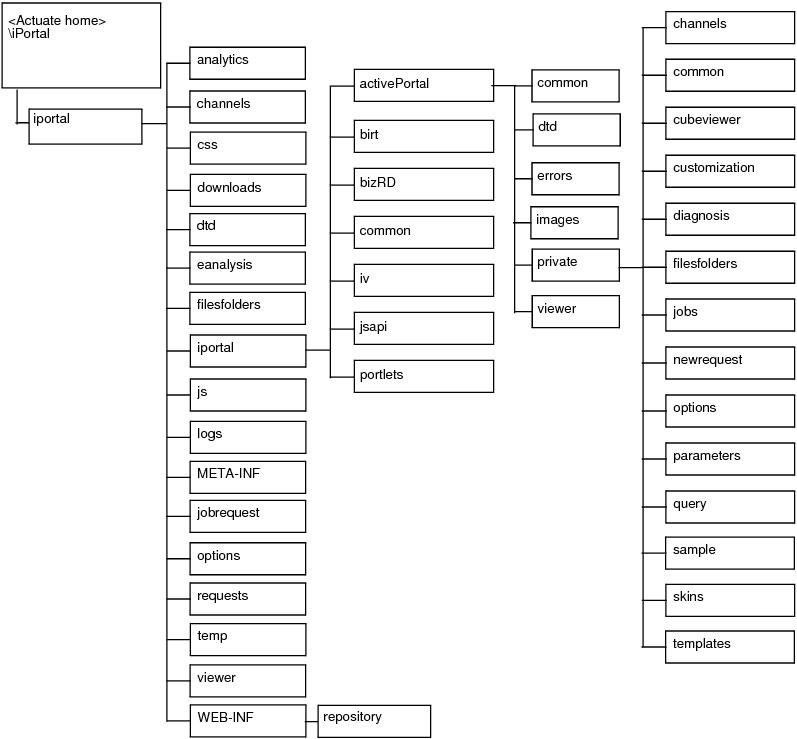Understanding Information Console directory structure
The Java Server Pages (JSPs) that implement Actuate Information Console URIs are grouped by method into directories under the context root. The context root is the home directory in which an Actuate Information Console web application resides. The default context root for the embedded Information Console for iServer on Windows systems is <Actuate home>\iServer\servletcontainer\iportal and on UNIX and Linux systems is <Actuate home>/iServer/servletcontainer/iportal. The default context root for a separate Information Console installation on Windows systems is <Actuate home>\iPortal\iportal and on UNIX and Linux systems is <Actuate home>/iPortal/iportal. The Information Console context root name in the web or application server’s configuration file is iportal. Figure 2-1 shows the Information Console directory structure.
Actuate Information Console URIs convey user requests to Actuate BIRT iServer.
Pages supporting folder navigation and document viewing reside in the <context root>\iportal\activePortal directory. In this directory, pages supporting report viewing reside in the viewer directory, pages serving as templates for other pages reside in the templates directory, and so on. Some directory names exist in the iportal directory and also in the <context root>\iportal\activeportal\private subdirectory. Customize the JSPs in the private subdirectory. The directory of the same name in the iportal directory exists only for backward compatibility. Table 2-1 lists and describes the general iServer\servletcontainer\iportal or iPortal\iportal directories.
|
landing.jsp, the default page for accessing all Information Console functionality.
|
|
|
JavaScript files that control specific web page elements such as search, toolbar, and table of contents.
|
|
|
Pages that support new requests, such as parameter processing, scheduling, and job status pages.
|
|
|
Options-specific pages, such as channels, notification, and options update pages.
|
|
|
Pages in this directory provide backward compatibility for custom web applications referencing these pages by URL. Use the action paths and the private\jobs directory for new customization projects.
|
|
|
Files that manage session information such as current user login, roles, and volume.
|
Table 2-2 lists and describes the iportal directories.
|
Pages that support login and authentication and directories for the remaining pages for folder navigation and document usage.
|
|
|
Libraries that support BIRT reports, BIRT Studio, and Interactive Viewer and pages that support BIRT reports.
|
|
|
Common elements included in all reporting web pages, such as banner and side menu elements.
|
|
Table 2-3 lists and describes the <context root>\iportal\activePortal directories. This table does not describe the directories for backwards compatibility having the same name as the subdirectories of private that provide current functionality.
|
Pages that support login and authentication and directories for the remaining folder and document pages for the Information Console application.
|
|
|
Common elements included in all reporting web pages, such as banner and side menu elements.
|
|
|
Images for reporting web pages, such as buttons, icons, lines, and arrows.
|
|
|
Most Information Console folders and documents web pages. Users cannot directly access pages in this directory using URLs. These pages are customizable.
|
|
|
private\channels
|
|
|
private\common
|
Common elements included in all reporting web pages, such as banner and side menu elements.
|
|
private\cubeviewer
|
|
|
private\customization
|
|
|
private\diagnosis
|
|
|
private\filesfolders
|
|
|
Pages that support requests such as completed requests, successful submission, and details pages by redirecting.
|
|
|
private\newrequest
|
Pages that support new requests, such as parameter processing, scheduling, and job status pages.
|
|
Options-specific pages, such as channels, notification, and options update pages.
|
|
|
private\parameters
|
|
|
private\templates
|
Jakarta Struts template pages that simplify customization by handling common web page structure and functionality for many pages.
|
Actuate recommends that you group Information Console applications in the home directory of an Actuate distribution to make them easier to locate. Place the context root in whatever location your application requires. To ensure that the JSP engine locates your Information Console application’s context root, add its location to your JSP engine’s configuration file as a context root path.

